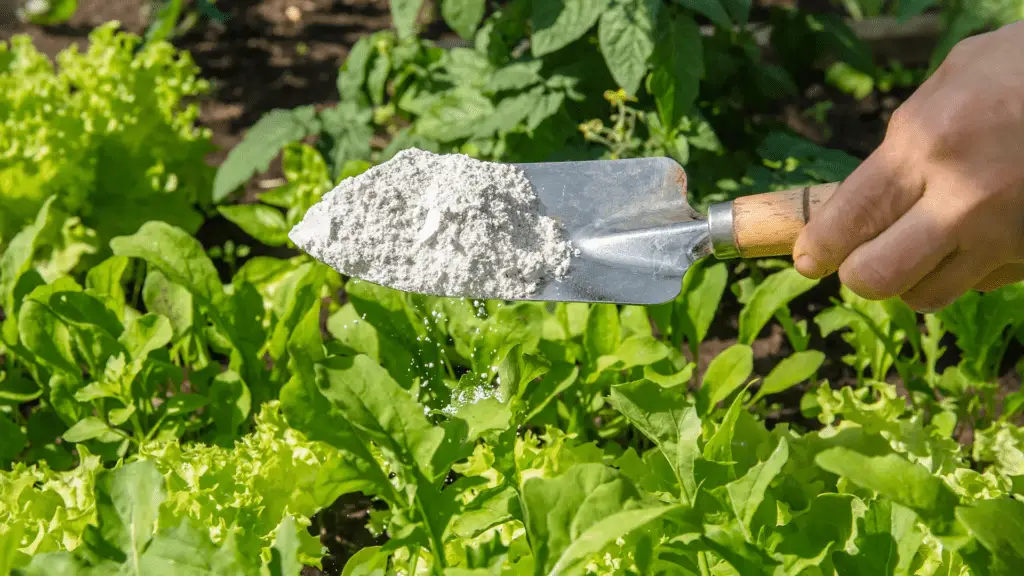How to Use Diatomaceous Earth: A Guide to Using This Natural and Safe Remedy for Your Plants
Table of Contents
Introduction to its Benefits and Composition
Diatomaceous earth, often referred to as DE, is a naturally occurring sedimentary rock that is composed of fossilized diatoms, a type of microscopic algae. This unique substance is rich in silica, which gives it its abrasive and absorbent properties. Due to its composition, diatomaceous earth has numerous benefits and applications in plant care.
One of the main advantages of using diatomaceous earth in plant care is its ability to control pests. When applied to the soil or foliage of plants, DE acts as a physical barrier that damages the exoskeletons of insects and causes them to dehydrate and die. This makes it an effective natural pesticide that can be used to combat a wide range of pests, including aphids, mites, beetles, and caterpillars.
In addition to pest control, diatomaceous earth also helps in promoting healthy plant growth. The abrasive nature of DE particles removes the outer waxy layer of pests, preventing them from feeding on the plants and reducing the risk of diseases. Furthermore, DE can improve soil structure and drainage, enhance nutrient absorption, and increase water retention capacity. All these factors contribute to a healthier and more robust plant growth, resulting in higher crop yields and healthier gardens. Diatomaceous earth is a versatile and effective tool that every gardening enthusiast should consider incorporating into their plant care routine.

Identifying the Common Uses of Diatomaceous Earth in Plant Care
Diatomaceous earth has gained popularity among gardening enthusiasts for its versatile uses in plant care. This natural substance, composed of fossilized diatoms, offers several benefits that promote healthy growth and protection against pests and diseases. One of the most common uses of diatomaceous earth in plant care is as a natural insecticide. Its abrasive texture damages the exoskeleton of crawling insects, causing them to dehydrate and eventually perish. By applying diatomaceous earth to the leaves and soil around your plants, you can effectively control pests such as aphids, slugs, and caterpillars without resorting to harsh chemical pesticides.
In addition to its insecticidal properties, diatomaceous earth is also a valuable tool for deterring and controlling plant diseases. The high silica content in diatomaceous earth helps strengthen plant cell walls, making them more resistant to fungal infections and other pathogens. This natural substance can be used as a preventive measure by applying it to healthy plants or as a treatment option for plants already affected by diseases. Its ability to absorb excess moisture also aids in creating a less favorable environment for fungal growth. With its dual action against pests and diseases, diatomaceous earth proves to be a convenient and environmentally friendly solution for plant care.
Selecting the Right Type of Diatomaceous Earth for Your Plants
When it comes to selecting the right type of diatomaceous earth for your plants, it’s important to consider a few key factors. First and foremost, you’ll want to determine the intended use of the diatomaceous earth. Is it for pest control, soil amendment, or some other purpose? Different types of diatomaceous earth may have varying levels of efficacy depending on the specific application.

Secondly, it’s crucial to assess the quality and purity of the diatomaceous earth product. Look for products that have been tested and certified to ensure they meet industry standards for purity and effectiveness. This will help ensure that you’re getting a high-quality product that will deliver the desired results without any harmful additives or impurities.
Lastly, consider the particle size of the diatomaceous earth. This can impact its effectiveness in various applications. Finer particles are often more effective for pest control, as they have a larger surface area to make contact with insects. Coarser particles, on the other hand, may be more suitable for soil amendment purposes.
By carefully considering these factors and choosing the right type of diatomaceous earth for your specific needs, you can optimize its benefits and ensure the health and vitality of your plants.
Preparing Your Plants for Diatomaceous Earth Application: Precautions and Considerations
Before applying diatomaceous earth to your plants, it is essential to take certain precautions and considerations to ensure the best possible results. Firstly, it is crucial to wear appropriate protective gear such as gloves, goggles, and a dust mask when handling diatomaceous earth. This is because the fine particles of diatomaceous earth can be abrasive to the skin and eyes, and inhalation of the dust may cause respiratory irritation.
In addition, it is important to closely inspect your plants for any signs of infestation or disease before applying diatomaceous earth. If your plants are already experiencing issues, it is advisable to address those problems first before applying diatomaceous earth. Treating plants with diatomaceous earth when they are already weakened or stressed may further harm them.
Furthermore, it is essential to follow the instructions provided by the manufacturer regarding the application rates and methods. Using too much diatomaceous earth can be counterproductive and may result in excessive drying of the plants or clogging of the soil. On the other hand, using too little may not effectively protect your plants from pests.

By taking these precautions and considerations, you can ensure that your plants are properly prepared for the application of diatomaceous earth, minimizing any potential risks and maximizing the benefits it provides.
Step-by-Step Guide to Applying Diatomaceous Earth to Your Plants
Applying diatomaceous earth to your plants is a simple and effective way to protect them against pests and enhance their overall health. Follow this step-by-step guide to ensure proper application:
1. Choose the right time: Apply diatomaceous earth on a calm day when there is no wind to minimize the risk of it being blown away. Avoid applying it during the heat of the day to prevent damage to your plants.
2. Prepare the area: Before applying diatomaceous earth, remove any debris or dead plant material from around your plants. This will help ensure better coverage and effectiveness.
3. Wear protective gear: Diatomaceous earth can cause irritation to your skin and eyes, so it is important to wear gloves, goggles, and a dust mask while handling and applying it. This will help protect you from any potential side effects.
4. Apply evenly: Sprinkle the diatomaceous earth evenly around the base of your plants, applying a thin layer. Be sure to cover both the upper and lower leaves, as well as the stems, to ensure pests can’t escape or access your plants.
Remember to reapply after rain or heavy watering, as diatomaceous earth loses its effectiveness when wet. Following these steps will help you harness the power of diatomaceous earth for healthy and thriving plants.
Ensuring Proper Coverage: Techniques for Even Distribution of Diatomaceous Earth
Proper coverage and even distribution of diatomaceous earth are crucial for its effectiveness in plant care. By following the right techniques, you can ensure that your plants receive maximum protection against pests and diseases. Here are some tips to help you achieve optimal coverage:
1. Begin by thoroughly examining your plants and identifying areas that require treatment. Look for signs of infestation or vulnerability, such as pests, fungal growth, or wilted leaves.
2. Once you have identified the target areas, it is important to apply diatomaceous earth evenly. This can be done by using a handheld dispenser or by employing alternative methods such as dusting with a brush or cloth.
3. Take care not to overapply the diatomaceous earth, as excessive dusting may create unnecessary mess or result in wastage. A light and even coating on the surface of the leaves, stems, and surrounding soil is sufficient for effective pest control.
4. Consider using a gentle, sweeping motion while applying diatomaceous earth to ensure even distribution. This will help the powder settle evenly and adhere to the plant surfaces, providing a protective barrier.
Remember to always follow the manufacturer’s instructions and consider wearing protective gear, such as gloves and a mask, during application. Taking these precautions and utilizing proper techniques will help you achieve the best possible coverage and ensure the successful use of diatomaceous earth in plant care.
Monitoring and Evaluating the Effects of Diatomaceous Earth on Your Plants
Once you have applied diatomaceous earth to your plants, it is important to monitor and evaluate its effects to ensure its efficacy. Monitoring allows you to closely observe the changes in your plants and determine whether diatomaceous earth is contributing to their overall health and well-being.
One way to monitor the effects of diatomaceous earth is by regularly inspecting your plants for any signs of pests or insect damage. Diatomaceous earth acts as a natural pest control method, effectively eliminating insects by piercing their exoskeletons and dehydrating them. By checking your plants for pests, such as aphids, slugs, or mites, you can assess whether diatomaceous earth is successfully deterring or eliminating these harmful organisms.
Additionally, monitoring plant growth and development is crucial in evaluating the effects of diatomaceous earth. Keep a close eye on the overall health and vitality of your plants, examining factors such as leaf color, stem strength, and flowering or fruiting patterns. Any improvements in these areas can indicate that diatomaceous earth is positively impacting your plants by providing essential minerals, promoting nutrient uptake, and enhancing overall plant vigor.
| Aspect | Monitoring Method | Evaluation Criteria |
|---|---|---|
| Pest Control | Regular inspection for pest presence | Reduction in pest population, decrease in damage to plants |
| Soil Health | Soil testing before and after application | Improved soil structure, increased nutrient availability |
| Plant Growth | Measurement of plant height and size | Increased growth rate, healthier foliage |
| Water Retention | Observing soil moisture levels | Enhanced water retention, reduced water runoff |
| Disease Resistance | Monitoring for signs of diseases | Decreased incidence of plant diseases |
| Environmental Impact | Observing impact on beneficial insects | Minimal negative impact on non-target organisms |
| Application Frequency | Tracking application intervals | Consistent effectiveness over time |
| Cost-Effectiveness | Cost analysis of diatomaceous earth | Economic benefits in pest control and plant health |
Potential Risks and Side Effects of Using Diatomaceous Earth on Plants
Potential Risks and Side Effects of Using Diatomaceous Earth on Plants
While diatomaceous earth is generally considered safe for use in plant care, there are some potential risks and side effects to be aware of. One of the main concerns is the abrasive nature of diatomaceous earth particles. When applied in excessive amounts or without proper precautions, it can cause physical damage to plants. This can include scraping or puncturing the plant’s delicate tissues, leading to wounds that can leave the plants vulnerable to infections or diseases.
Additionally, diatomaceous earth has the potential to deplete the moisture content in the soil. This can be a problem for plants that require a consistently moist environment, as the excessive drying effect of diatomaceous earth can lead to wilting or even death. It is crucial to monitor the moisture levels of the soil and adjust watering accordingly when using diatomaceous earth as a plant care technique.
Furthermore, it is worth noting that diatomaceous earth can pose a risk to beneficial insects, such as bees and ladybugs. While it is effective in controlling pests like aphids and mites, it can also harm beneficial insects if they come into direct contact with the substance. Gardeners who wish to protect these beneficial creatures should consider alternative methods or take precautions by applying diatomaceous earth only in areas where it won’t directly impact them.
It is essential to consider these potential risks and side effects before incorporating diatomaceous earth into your plant care routine. While it can be an effective and natural solution for dealing with pests, proper application and monitoring are necessary to ensure the well-being of your plants and the surrounding ecosystem.
Alternative Methods for Incorporating Diatomaceous Earth in Your Plant Care Routine
There are various alternative methods that can be incorporated into your plant care routine to maximize the benefits of diatomaceous earth. One effective approach is to combine diatomaceous earth with organic fertilizers, such as compost or manure, when feeding your plants. By mixing these substances together, you can provide your plants with a rich source of nutrients while also benefiting from the pest control properties of diatomaceous earth.
Another method worth considering is creating a diatomaceous earth spray. To make this spray, simply combine diatomaceous earth with water and a natural surfactant, such as liquid soap or neem oil. This solution can then be applied directly onto the leaves of your plants using a spray bottle. Not only does this help to control pests that may be residing on the foliage, but it can also act as a protective barrier against future infestations.
By incorporating these alternative methods into your plant care routine, you can enhance the efficacy of diatomaceous earth and promote the overall health and vitality of your plants. However, it is important to remember that each method should be used in accordance with proper guidelines and precautions to ensure the safety of both your plants and yourself.
Integrating Diatomaceous Earth into Organic Gardening Practices
Integrating diatomaceous earth into organic gardening practices offers an effective and natural solution for maintaining healthy plants. With its potent insecticide and fungicide properties, diatomaceous earth provides sustainable pest control without the use of harmful chemicals. By incorporating this versatile substance into your gardening routine, you can enhance the overall success of your organic garden.
One key benefit of incorporating diatomaceous earth into organic gardening practices is its ability to control common garden pests. Diatomaceous earth works by damaging the protective waxy layer of insects, causing them to dehydrate and eventually perish. This mineral-based solution is particularly effective against soft-bodied pests such as aphids, slugs, and snails, as well as crawling insects like ants and beetles. By integrating diatomaceous earth into your organic gardening practices, you can minimize pest damage and reduce the need for synthetic pesticides, ensuring a healthier and more sustainable gardening environment.
Furthermore, integrating diatomaceous earth into organic gardening practices can also assist in controlling fungal infections. The fine powder structure of diatomaceous earth acts as a physical barrier, absorbing excess moisture from plant surfaces and preventing the growth of fungi. This can be particularly beneficial in preventing powdery mildew and other fungal diseases that commonly affect plants. By applying diatomaceous earth as a preventative measure, you can safeguard your plants and promote their overall health and vitality.
Optimizing the Long-Term Benefits of Diatomaceous Earth for Your Plants
To optimize the long-term benefits of diatomaceous earth for your plants, it is crucial to consider a few key factors. Firstly, it is important to understand the specific needs of your plants and how diatomaceous earth can contribute to their overall health and well-being. Every plant species has unique requirements, so it is essential to research and identify the specific benefits that diatomaceous earth can provide for your plants.
Additionally, proper application and dosage play a significant role in maximizing the benefits of diatomaceous earth. It is recommended to follow the manufacturer’s instructions and guidelines for the appropriate application rates. Over-application can potentially harm plants, while under-application may not provide the desired effects. Taking the time to understand the correct usage and dosage will help ensure that your plants receive the full benefits of diatomaceous earth without any negative consequences.
Furthermore, regular monitoring and evaluation are vital for optimizing the long-term benefits of diatomaceous earth. By closely observing the effects of diatomaceous earth on your plants, you can make adjustments as needed and tailor your application methods accordingly. This includes regularly inspecting plant growth, leaf health, and overall vitality. Assessing the impact of diatomaceous earth on your plants’ progress will enable you to fine-tune your approach and make informed decisions to optimize the long-term benefits.
Addressing Frequently Asked Questions About Using Diatomaceous Earth for Plant Care
Frequently Asked Questions About Using Diatomaceous Earth for Plant Care
Question 1: Can diatomaceous earth harm beneficial insects in my garden?
Answer: Diatomaceous earth is generally safe for beneficial insects such as bees and ladybugs. Its method of action is primarily physical, not chemical, meaning it does not pose a direct threat to these helpful creatures. However, it is essential to apply diatomaceous earth only to specific areas and avoid scattering it over plant surfaces where beneficial insects frequent. By focusing the application on areas where pests are concentrated, you can minimize the potential impact on beneficial insects while still effectively controlling unwanted pests.
Question 2: Can diatomaceous earth be harmful to pets or humans?
Answer: When used correctly, diatomaceous earth is considered safe for pets and humans. However, it is crucial to exercise caution during application and avoid direct inhalation of the fine dust particles. As with any fine airborne substance, inhaling diatomaceous earth can irritate the respiratory system. Therefore, it is advisable to wear a face mask and work in a well-ventilated area when applying diatomaceous earth. Additionally, keep pets away from treated areas until the dust has settled to prevent accidental exposure. If ingested in large quantities, diatomaceous earth can cause digestive discomfort, so it is best to store it securely and out of reach of children and pets.
Summarizing the Key Takeaways: Harnessing the Power of Diatomaceous Earth for Healthy Plants
Diatomaceous earth, with its myriad benefits and natural composition, presents a powerful tool for promoting the health and vitality of your plants. By incorporating diatomaceous earth into your plant care routine, you can address a wide range of issues, from pest control to fungal prevention, and even improve soil structure. Its versatile uses make it a valuable asset for both indoor and outdoor gardening enthusiasts.
To harness the power of diatomaceous earth effectively, it is crucial to select the right type for your plants. Different formulations cater to specific needs, such as food-grade diatomaceous earth for edible plants or horticultural-grade for non-edible plants. Preparing your plants for diatomaceous earth application requires careful consideration, ensuring that your plants are healthy and free from excess moisture. By following a step-by-step guide, you can easily apply diatomaceous earth to your plants, promoting even distribution and optimal coverage.
With proper monitoring and evaluation, you can gauge the effects of diatomaceous earth on your plants. Regular observation allows you to assess its effectiveness and make necessary adjustments to your plant care routine. As with any method, there are potential risks and side effects to be aware of when using diatomaceous earth on plants, such as eye and respiratory irritation. By following recommended safety precautions, you can mitigate these risks and ensure a safe gardening experience.
For those seeking alternative methods and organic gardening practices, integrating diatomaceous earth into your routine can provide long-term benefits. It enhances soil health and promotes a balanced ecosystem. By optimizing the use of diatomaceous earth, you can create a sustainable environment for your plants to thrive.
In conclusion, diatomaceous earth offers a natural and effective solution for maintaining the health of your plants. By selecting the appropriate type, taking necessary precautions, and monitoring its effects, you can harness its power to tackle various plant care challenges. Whether you choose to incorporate it into your organic gardening practices or explore alternative methods, diatomaceous earth can be a valuable tool in your gardening arsenal.
What is diatomaceous earth?
Diatomaceous earth is a naturally occurring sedimentary rock that is made up of the fossilized remains of diatoms, which are microscopic algae-like plants.
How does diatomaceous earth benefit plants?
Diatomaceous earth can benefit plants by improving soil structure, promoting nutrient absorption, controlling pests, and reducing fungal infections.
Can diatomaceous earth be harmful to plants?
When used according to instructions, diatomaceous earth is generally safe for plants. However, excessive application or using the wrong type can potentially harm plants.
How do I select the right type of diatomaceous earth for my plants?
It is important to choose food-grade diatomaceous earth specifically made for plant care. Avoid products that contain added chemicals or pesticides.
How should I prepare my plants before applying diatomaceous earth?
Before application, make sure to clean and remove any debris from your plants. Ensure that the soil is slightly damp to help the diatomaceous earth adhere to the plant.
How do I apply diatomaceous earth to my plants?
Apply diatomaceous earth by lightly dusting it onto the leaves and stems of your plants, as well as around the soil. Avoid excessive application that could smother the plant.
How long does it take to see the effects of diatomaceous earth on plants?
The effects of diatomaceous earth on plants can vary, but you may start to notice improvements within a few days to a couple of weeks, depending on the specific issue being addressed.
Are there any risks or side effects associated with using diatomaceous earth on plants?
When used properly, diatomaceous earth is generally safe for plants. However, inhalation of the dust can irritate the respiratory system, so it is important to take precautions and wear protective gear when applying it.
Can I use diatomaceous earth in organic gardening practices?
Yes, diatomaceous earth is considered acceptable for use in organic gardening, as long as you select a food-grade product without added chemicals.
How can I optimize the long-term benefits of diatomaceous earth for my plants?
Regularly monitor and evaluate the effects of diatomaceous earth on your plants. Adjust application rates as needed and incorporate it into your regular plant care routine for continued benefits.
Can diatomaceous earth be used on edible plants?
Yes, diatomaceous earth can be safely used on edible plants. However, make sure to wash the harvested produce thoroughly before consuming.
Can diatomaceous earth be used indoors?
Yes, diatomaceous earth can be used indoors for plants. However, be cautious of excessive dust and consider using a mask or applying it in a well-ventilated area.

Pallavi Gupta is a burgeoning writer at SouthElMonteHydroponics, blending her passion for data analysis with a keen interest in biotechnology. Currently pursuing a Bachelor’s in Biotechnology at Amity University, Pallavi delves into the intricacies of life sciences while gaining hands-on experience in the exciting world of data analysis. Her unique background provides a fresh perspective on hydroponic farming, as she explores the intersection of biotechnology and sustainable agriculture. Through her writing, Pallavi aims to bridge the gap between data-driven insights and innovative farming practices, inspiring others to harness technology for a greener future.







